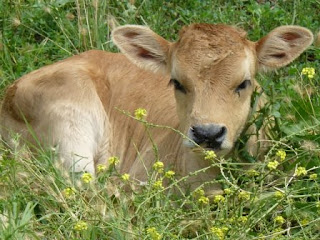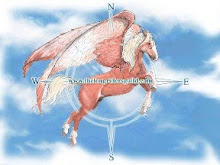During the next 50-100 years, if we do not change our ways, fifty percent of all the variety of life on earth will be extinct.
These pictures show what we will lose.
I have been walking and riding over the Greek mountains for thirty years or so.
During that 30 years the number of individual creatures- birds, mammals, fish, amphibians and reptiles, insects - all individual creatures- has dropped by 25% worldwide. That means that I am 25% less likely to see these creatures than I was when I first started to walk and ride in Greece. Many of them, which were rare then, I shall never see again.
Those who come after us will never see them at all.
What are we doing?
Can`t we stop doing it?
We have a choice. We MUST face reality. Then we can decide if we want to keep what Darwin called "Endless forms most beautiful and most wonderful."
Some people may wonder why there is a picture of a calf amongst all the wild things. It is because the calf IS a wild thing. It is one of the "wild" cattle found on Mt Stratoniko in Halkidiki. They were declared extinct in 2000, but, as the photo shows they are not. Wild cattle in Greece? who`d have thought it?
I haven`t put the names of the creatures and flowers on the page, but if you think I should please make a comment to that effect.
A comment to that effect has been made by Aegistos. Since he fixed a problem which the blog had with the FOLLOW button (caused by your author`s stupidity) I feel I should oblige him with a list of names.
There follows a list in the same order as the photos:
1. Caterpillar of the Spurge Hawkmoth (Hyles euphorbiae)
2. Wild Tulip. Varies greatly according to location but these red ones are probably (Tulipa goulimyi) very rare. These were in Antikythera, but tulips of various kinds are found throughout Greece. Modern farming methods have meant that they are becoming rare.
3. Greek wild cattle of the Sikea breed,( or Sikeotis) found on Mt Stratoniko and the Zepko peninsular. Declared extinct by Aristotle University research study in 2000.
4.Wild Gladiolus (Gladiolus italicus) Several species and varieties within species in Greece, but this is probably Italicus. This plant used to be common but is getting rarer becaus of changes in farming and loss of habitat.
5. Long Eared Owl (Asio otus)
6. Stink horn fungus (Phallus impudicus)
7. Orb web spider not sure exactly which member of the Argiopidae family this one is.
8. Hair worm. These belong to a family of parasitic NEMATOMORPHA which drive their insect host to suicide in water when they need to metamorphose. I don`t know exactly which hairworm this is as I didnt see the poor insect that delivered it to the puddle where I found it. Indeed when I found it I was puzzled as to how it could have got to the water as it didn`t seem to be able to move much. Then I found out how it got there. What a nasty little animal.
9. Newly hatched Stripe Necked Terrapin (Mauremys caspica)
10. Peacock butterfly (Inachis io)
11. Yellow brain fungus (Tremella mesenterica)
12.Stink Bug. (Graphosoma italicum) So called because it ...smells lovely..The red and black stripes warn everyone not to mess with this creature, and so it is not uncommon.
13. African Chameleon. ( Chamaeleo africanus)The rarest land vertebrate in Europe.
Almost extinct. One population remains near Pylos. Threatened by unconsidered development in that area. Although it is called African Chameleon, it is probably a relict population of a species once found throughout the mediterranean.Or it may be that the Romans brought them.. Andrea Bonetti (a follower of this blog) discovered that the chameleons living in Pylos were a separate species from the other type of chameleons found in Europe. He has been trying to protect them from extinction ever since.
14. Large Whip Snake,( Dolichophis caspius )
15. Marsh frog (Rana ridibunda)
16. Kotschy`s gecko ( Cyrtodactylus kotschyi)
17. Agamid lizard (Laudakia stellio)
18. Keeled skimmer (Orthetrum cerulescens)
19. Wild pear (Pyrus pyraster)
20. Wild cat (Felix sylvestris) This is probably the eastern type.
If I`ve made any blunders please correct them by commenting in the comments section in the main blog. Thankyou.
Here I`m going to add an advertisement for my book - called Six Antidotes to Technology. I made the book to help visitors to Nymphaeon, in Northern Greece, regain contact with Nature. I had designed and signposted 6 walks of differing lengths in the countryside around Nymphaeon, and the book is a guidebook designed to help people reclaim their lost connection with the wild.
Max Frisch defined technology as: “The knack of so arranging the world that we need not experience it” One of the walks was called the "Antidote to Technology Walk": I hoped it would provide a way for people to get away from technology and really experience the world. When we were trying to think of a title for the book Vasso Petridou at Arcturos suggested that if one walk was an antidote to technology, then they all were. And I thought that was a fantastic title for the whole book.
I wrote the book because I believe that if people can find a way to experience the natural world they will KNOW that we can`t let it go.
Mihalis Boutari gave me the chance to do this because he believes the same thing.
It was something that I could do to help people make an informed choice about what kind of world they want to live in. I hope my ride will do more of the same.
Just a word of warning about the Greek version of the book. One night, when everyone was sleeping, Arcturos was visited by the Fuckup Fairy. . She could have messed up accounts, or education, or volunteers, but she didn`t. She concentrated on MY book. Oddly she only attacked the Greek version with any real determination. She more or less left the English version alone.
.


























